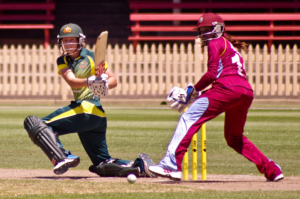What is powerplay in cricket? Cricket is a lively game that has changed a lot over the years, and one exciting term that always adds a lot of fun to the game is “Powerplay.”
Whether you’re a seasoned cricket enthusiast or a newcomer eager to comprehend the sport, understanding the concept of Powerplay can significantly amplify your appreciation, particularly in limited-overs formats such as T20s and ODIs.
Let us delve into this article and understand- what is powerplay in cricket and its basic rules.
What is Powerplay in Cricket?
Powerplay, in essence, refers to a specific set of overs during a limited-overs cricket match characterized by distinctive fielding regulations.
Though it may initially appear intricate, a closer inspection reveals the simplicity underlying its strategic dynamics.
Basic Powerplay Rules
In One Day Internationals (ODIs), the PowerPlay unfolds across distinct phases:
Mandatory Powerplay (First 10 overs): This initiates with only two fielders allowed beyond the 30-yard circle.
Also know as powerplay 1 (PP1)
Overs 11 to 40: The regulations relax slightly, permitting a maximum of four fielders outside the 30-yard circle.
Also known as powerplay 2 (PP2)
Final ten overs (Overs 41 to 50): The constraint further eases, allowing up to five fielders to operate beyond the 30-yard circle.
Also known as powerplay 3 (PP3)
For Twenty20 (T20) matches, the rules simplify the dynamics even further:
Overs 1 to 6: A stringent phase with only two fielders allowed outside the 30-yard circle.
Overs 6 to 20: The limit expands to five fielders beyond the 30-yard circle.
Additionally, the leg side rule maintains a cap of five fielders on the leg side throughout the match, ensuring a balance in defensive and attacking strategies.
What does a Thirty-Yard Circle mean in Cricket?
The 30-yard circle is a fielding restriction area in cricket marked by a circle with a radius of 30 yards (approximately 27.43 meters) from the centre of the pitch.
This circle is a critical component of limited-overs cricket, specifically in One Day Internationals (ODIs) and Twenty20 (T20) matches.
During certain phases of the game, particularly in the Powerplay overs, fielding restrictions come into play, dictating the number of fielders allowed outside this 30-yard circle.
The purpose of these restrictions is to encourage more aggressive and entertaining cricket by allowing batters to score more freely.
Evolution of Powerplay Rules in Cricket
The landscape of One Day International (ODI) cricket has witnessed a fascinating growth in its Powerplay rules, reshaping the game and intensifying its dynamics.
Let’s look through the decades, uncovering the transformation of Powerplay regulations.
Beginning of Field Rules in the 1980s
The concept of field restrictions, the precursor to Powerplay, debuted in the 1980/81 ODI season in Australia.
These restrictions aimed to counteract the prevalence of defensive strategies that dominated limited-overs matches.
Batsmen, rooted in the Test-Cricket mindset, prioritized wicket preservation over aggressive run accumulation, leading to notably slow innings, exemplified by Sunil Gavaskar’s marathon 60-over effort, scoring only 36 runs.
1992 World Cup
The 1992 Cricket World Cup marked a pivotal moment in the evolution of Powerplay rules.
Amendments permitted two fielders outside the 30-yard circle in the first 15 overs and five fielders, introducing a semblance of flexibility.
The inception of Powerplay and Rule Changes in 2005
The advent of T20 cricket in 2005 saw the formal introduction of the term “Powerplay” into international matches.
Significant alterations ensued:
The powerplay overs increased from 15 to 20, divided into 10 mandatory overs and two optional sets of 5 overs each.
The requirement for two fielders in the “catching position” was reduced to the first ten overs.
Bowlers gained the flexibility to choose the two sets of 5-over powerplays between overs 11 and 45.
The term “Mandatory Powerplay” emerged, allowing captains strategic flexibility in choosing when to capitalize on the powerplay.
Powerplay Rule Changes in 2008
In 2008, a crucial modification empowered the batting team to choose one of the two 5-over powerplays.
The objective was to mitigate the lull in scoring rates during the middle overs, allowing teams to strategically accelerate runs when the batsmen were well set.
However, this change presented challenges, with batting teams often losing wickets during the powerplay, impacting their strategy and leading to suboptimal outcomes.
Powerplay Rule Changes in 2012
In 2012, adjustments were made to refine the Powerplay rules:
The number of powerplays was reduced to two – a mandatory powerplay in the first 10 overs and a batting powerplay between overs 16 to 36 for the batting team.
The maximum number of fielders outside the 30-yard circle during non-powerplay overs decreased to 4.
These alterations spurred a surge in run rates throughout matches, reflected in some of the highest-scoring ODIs during that era.
Current Powerplay Rule (Revised in 2015)
The rules underwent a significant overhaul in 2015:
Three mandatory powerplays replaced the previous structure – the first for 10 overs, the second for 30 overs, and the third for 10 overs.
The requirement of a minimum of two fielders in catching positions during the first 10 overs was eliminated.
All three powerplays are now compulsory, removing the distinction between batting and bowling powerplays.
These changes sought to strike a balance between batting and bowling, allowing an additional fielder outside the 30-yard circle in the last 10 overs and rejuvenating the equilibrium in ODI cricket.
Conclusion
The evolution of Powerplay rules in cricket mirrors the sport’s dynamic adaptation to balance aggression and strategy.
From the inception of field restrictions in the 1980s to the modern three-phase Powerplay introduced in 2015, each shift sought to invigorate the game.
Despite challenges and occasional drawbacks, these changes revitalized cricket, fostering a more engaging and unpredictable narrative.
The journey through Powerplay’s transformation showcases cricket’s commitment to innovation, ensuring a compelling blend of strategy, skill, and excitement.
As the sport continues to evolve, the legacy of Powerplay stands as a testament to cricket’s resilience and ever-changing spirit.
Also, check out Top Batsmen With Most Centuries in T20 International Cricket







